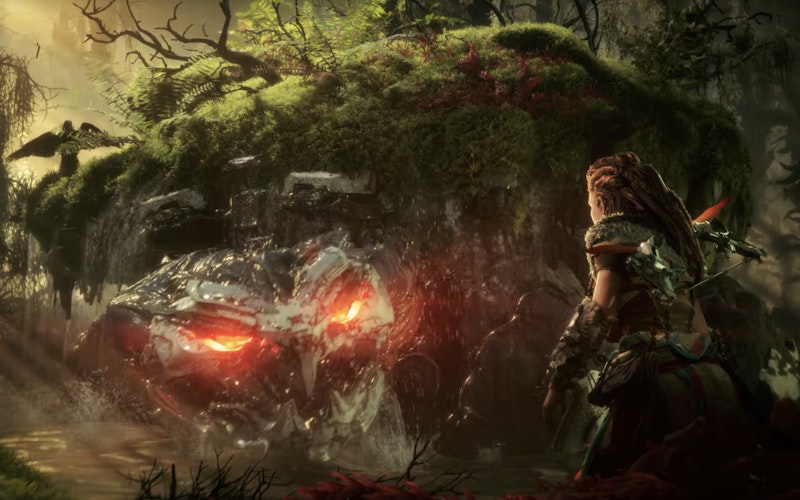
Games
Destruction and Resurrection in Horizon Forbidden West
We really love destroyed societies in pop culture.
How else do you explain the incredibly diverse and creative spread of apocalyptic scenarios cooked up by a host of authors, directors, and designers? We can’t get enough of zombie mayhem or dysfunctional politics or alien invasions or global plagues. (Even in the middle of a real one!) What is going on here? Could it be that our fascination is not so much tied to an obsession with destruction, but a hope of resurrection?
Guerrilla Games’ Horizon series—composed of 2017’s Horizon Zero Dawn and the recently released sequel, Horizon Forbidden West—is an interesting twist on the genre. Set in the remains of a ruined United States, Forbidden West features technologically primitive groups fighting for survival amidst mechanical beasts. It’s a strange place where highly advanced technology and tribal mysticism coexist.
A stunningly beautiful and massive open-world game—Forbidden West is the first title that takes the power of the new Playstation 5 for a real spin. The player controls Aloy, a red-haired outcast of the Nora hunters, who is incredibly skilled at just about everything: climbing sheer cliffs, sneaking past cultist warriors, singlehandedly killing massive mechanical monsters, and opening ancient ruins in order to uncover their secrets.
As you play, Aloy unlocks a tremendously rich web of narratives. Throughout the land, there are various nations with differing religions, politics, and economic activities. There is also the mystery of the Old Ones and what led to their downfall. Aloy picks up a “Focus”—a wearable computing device that provides data overlays. These give her special insights into the wild machines and many other phenomena. Perhaps most importantly, the Focus allows her to piece together the story of why this civilization collapsed.
For all its unique artistry, Horizon Forbidden West stands alongside other post-apocalyptic games like The Last of Us, Fallout 1 through 4, and Death Stranding. Why do we keep coming back to this well? With texts this complex, there can’t be just one reason, but I have a hunch that a big part of the motivation is that we are people who crave the hope of resurrection. (Spoilers ahead for the Horizon games.)
Why do we keep coming back to this well?
In the Horizon series, humans have, for many centuries, lived in a strange equilibrium with the mechanical beasts. Something destroyed our ancient civilization, but people re-emerged and rebuilt. And then, everything is threatened again, as the machines start to become increasingly hostile. As Aloy goes on a quest in the first game to help her people she learns the truth: that the destruction of the world was, in fact, total—not just an annihilation of humanity, but a destruction of all organic life on the earth’s surface, thanks to an out-of-control artificial intelligence. Here’s where it gets interesting: at the core of the narrative from the distant past is a savior figure, Dr. Elisabet Sobeck. Thanks to her foresight, tenacity, and courage, the rebirth of the world is possible via her Horizon Zero Dawn project. In this, she’s reminiscent of none other than Jesus Christ.
Aloy—who turns out to be a machine-birthed clone of Sobeck—further encourages this Christ-figure reading in Horizon Zero Dawn and now again in Horizon Forbidden West. Not only are her genetics the key to taming out-of-control machinery and her impossible competence critical to successfully overcoming various dangerous challenges, but in big ways and small, she models faith, hope, and love. Most importantly, she is ready to sacrifice herself to save her world.
What is ironic about this is that both games suggest that religions, even the good ones, are created out of ignorance. We encounter many different traditions: the matriarchal spiritualism of the Nora; the complex priesthood of the supposedly civilized Carja; and the peaceful agricultural practices of the Utaru. But the games make clear that in the absence of true understanding of the world they find themselves in, these post-apocalyptic peoples created imaginary gods and narratives. When they learn the true history of the ancient ruins and apocalypse, as Aloy has, they typically become disenchanted with their religion. After a technological fall, the Horizon games seem to say, only a technological resurrection can save us.
And yet this highly secular game revolves around an ancient spiritual narrative: evil in the world threatens life and goodness, requiring a dying savior to bring new life. A modern agnostic or atheist might say that narratives like this help people collectively process the challenges we continually face. I would agree with this on some level. But I also think one of the reasons we keep going to the apocalypse and the hope of life afterwards is because we are replaying the story of God, his creation, and his people.
Whether we acknowledge God’s existence or not, we need him. We are caught in an originally good creation that has been marred by sin and brokenness. This world is often scary, full of death and decay. Whether we acknowledge it or not, we know in our hearts that complete renewal will not come from within. Our own efforts will always be flawed, always tainted by the very poison we’re trying to stop. We need hope from beyond—we need a savior. Every Aloy is another attempt to envision the meeting of that need.
The prophets of the Bible purposely retreated to the wastelands to experience God more closely. Maybe we hear an echo of that tradition in our own stories of the apocalypse. For it is in the desolation of destruction that we most powerfully experience the joy of the resurrection.
Topics: Games